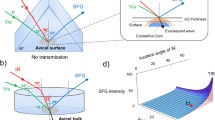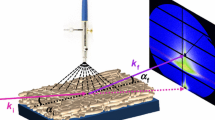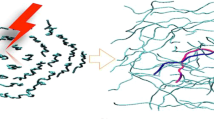Abstract
Sum frequency generation vibrational spectroscopy (SFS) was employed to study the alkyl ketene dimer (AKD) sizing mechanism employed in the papermaking industry for hydrophobization of cellulose. The AKD was spun coat onto model cellulose films, which resulted in ≈ 2.6 nm thick AKD layers. The chain orientation of AKD molecules during the sizing process was measured at different temperatures. It was demonstrated that the chain orientation and conformation of AKD do not correlate with observed changes in sizing. The distribution of AKD molecules on model cellulose surfaces as a function of time and temperature was imaged via fluorescence microscopy to complement SFS measurements. It was concluded that the distribution of AKD plays a major role in the sizing effect.
Graphical abstract


















Similar content being viewed by others
References
Bain CD (1995) Sum-frequency vibrational spectroscopy of the solid/liquid interface. J Chem Soc Faraday Trans 91:1281–1296
Bajpai P (2010) Environmentally friendly production of pulp and paper. Wiley, Hoboken
Barnette AL, Bradley LC, Veres BD, Schreiner EP, Park YB, Park J, Park J, Park S, Kim SH (2011) Selective detection of crystalline cellulose in plant cell walls with sum-frquency-generation (SFG) vibration spectroscopy. Biomacromolecules 12:2434–2439
Bottorff KJ, Sullivan MJ (1993) New insights into the AKD sizing mechanism. Nordic Pulp Paper Res J 8:86–95
Chen Z, Shen YR, Somorjai GA (2002) Studies of polymer surfaces by sum frequency generation vibrational spectroscopy. Annu Rev Phys Chem 53:437–465
Conboy JC, Messmer MC, Richmond GL (1996) Investigation of surfactant conformation and order at the liquid-liquid interface by total internal reflection sum-frequency vibtational spectroscopy. J Phys Chem 100:7617–7622
Edgar CD, Gray DG (2003) Smooth model cellulose I surfaces from nanocrystal suspensions. Cellulose 10:299–306
Eklund D, Lindstrom T (1991) Paper chemistry: An introduction. DT Paper Science Publications, Grankulla
Eriksson J, Malmsten M, Tiberg F, Callisen TH, Damhus T, Johansen KS (2005) Enzymatic degradation of model cellulose films. J Colloid Interface Sci 284:99–106
Esser A, Ettl R (1997) On the mechanism of sizing with alkyl ketene dimer (AKD): physico-chemical aspects of AKD retention and sizing efficiency. In: Fundamentals of papermaking materials, vol 2. Pira Int, pp 997–1020
Falt S, Wagberg L, Vesterlind EL, Larsson PT (2004) Model films of cellulose II—improved preparation method and characterization of the cellulose film. Cellulose 11:151–162
Garnier G, Wright J, Godbout L, Yu L (1998) Wetting mechanism of alkyl ketene dimers on cellulose films. Colloids Surf A 145:153–165
Gess JM, Rende DS (2005) Alkenyl succinic ankydride (ASA). Tappi J 49:25–30
Gunnars S, Wagberg L, Stuart MAC (2002) Model films of cellulose: I. Method development of initial results. Cellulose 9:239–249
Isogai A (1997) Factors influencing on retention of alkyl ketene dimer. In: Fundamentals of papermaking materials, vol 2. Pira Int, pp 1047–1071
Kontturi E, Thune PC, Niemantsverdriet JW (2003) Novel method for preparing cellulose model surfaces by spin coating. Polymer 44:3621–3625
Lambert AG, Neivandt DJ, Briggs AM, Usadi EW, Davies PB (2002) Interference effects in sum frequency spectra from monolayers on composite dielectric/metal substrates. J Phys Chem B 106:5461–5469
Li L, Neivandt DJ (2016) Interference effects in femtosecond sum frequency spectra from model cellulose films. J Phys Chem C 120:17296–17307
Makarem M, Lee CM, Kafle K, Huang S, Chae I, Yang H, Kubicki JD, Kim SH (2019) Probing cellulose structures with vibrational spectroscopy. Cellulose. https://doi.org/10.1007/s10570-018-2199-z
McGall SJ, Davies PB, Neivandt DJ (2004) Interference effects in sum frequency vibrational spectra of thin polymer films: an experimental and modeling investigation. J Phys Chem B 108:16030–16039
Mischki TK, Donkers RL, Eves BJ, Lopinski GP, Wayner DDM (2006) Reaction of alkenes with hydrogen-terminated and photooxidized silicon surfaces. A comparison of thermal and photochemical processes. Langmuir 22:8359–8365
Olin P, Lindström SB, Wågberg L (2015) Trapping of water drops by line-shaped defects on superhydrophobic surfaces. Langmuir 31:6367–6374
Roberts JC (1991) Paper chemistry. Chapman and Hall, New York
Roberts JC (1996) The chemistry of paper. RSC paperbacks. The Royal Society of Chemistry, Cambridge
Rohringer P, Bernheim M, Werthemann DP (1985) Are so-called reactive sizes really cellulose reactive? Tappi J 68:83–86
Scott WE (1996) Principles of wet end chemistry. Tappi Press, Atlanta
Seppanen R (2000) Mechanism of internal sizing by alky ketene dimers (AKD): the role of the spreading monolayer precursor and autophobicity. Nordic Pulp Paper Res J 15:452–458
Shen YR (1989) Surface properties probed by 2nd harmonic and sum frquency generation. Nature 337:519–525
Shen W, Brack N, Ly H, Parker IH, Pigram PJ, Liesegang J (2001) Mechanism of AKD migration studied on glass surfaces. Colloids and surfaces A: physicochem. Eng Asp 176:129–137
Shibuichi S, Onda T, Satoh N, Tsujii K (1996) Super water-repellent surfaces resulting from fractal structure. J Phys Chem 100:19512–19517
Tompkins HG, McGahan WA (1999) Spectroscopic ellipsometry and reflectometry. Wiley-Interscience, New York
Wang J, Buck SM, Chen Z (2003) The effect of surface coverage on conformation changes of bovine serum albumin molecules at the air-solution interface detected by sum frequency generation vibrational spectroscopy. Analyst 128:773–778
Watry MR, Richmond GL (2002) Orientation and conformation of amino acids in monolayers adsorbed at an oil/water interface as determined by vibrational sum-frequency spectroscopy. J Phys Chem B 106:12517–12523
Werner O, Quan C, Turner C, Pettersson B, Wagberg L (2010) Properties of superhydrophobic paper treated with rapid expansion of supercritical CO2 containing a crystallizing wax. Cellulose 17:187–198
Yu L, Garnier G (1997) Mechanism of internal sizing with alkyl ketene dimers: the role of vapor deposition. In: Fundamentals of papermaking materials, vol 2. Pira Int, pp 1021–1046
Acknowledgments
Financial support for the present work was kindly provided by the Graduate School, and the Forest Bioproduct Research Institute, of the University of Maine. Additional financial support was provided by the School of Materials Science and Engineering, of the University of Shanghai for Science and Technology. The authors thank Dr. Douglas W. Bousfield for assistance with the contact angle measurements, Dr. Samuel T. Hess for assistance with the fluorescence microscopy measurements, and Dr. Douglas Gardner for assistance with the AFM measurements.
Author information
Authors and Affiliations
Corresponding author
Additional information
Publisher's Note
Springer Nature remains neutral with regard to jurisdictional claims in published maps and institutional affiliations.
Rights and permissions
About this article
Cite this article
Li, L., Neivandt, D.J. The mechanism of alkyl ketene dimer (AKD) sizing on cellulose model films studied by sum frequency generation vibrational spectroscopy. Cellulose 26, 3415–3435 (2019). https://doi.org/10.1007/s10570-019-02295-2
Received:
Accepted:
Published:
Issue Date:
DOI: https://doi.org/10.1007/s10570-019-02295-2




